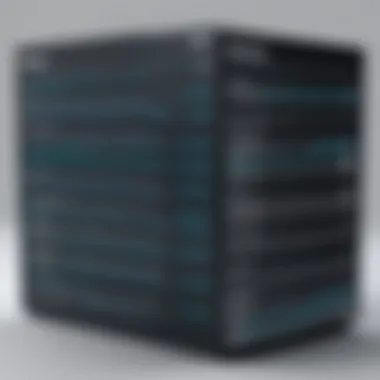Understanding Tithely Costs: In-Depth Analysis


Intro
In the digital age, online giving platforms play a critical role in the way organizations and individuals manage donations. Tithely has emerged as a strong contender in this space, offering a range of features designed to facilitate easy and effective giving. However, understanding the costs associated with Tithely is vital for both users and organizations considering this service. By analyzing various pricing models, features, and user experiences, this article aims to provide clarity on Tithely's cost structures.
Features and Capabilities
Overview of Key Features
Tithely offers several features that enhance the online giving experience. Some of its key functionalities include:
- Customizable Donation Forms: Users can create specific forms tailored to their organizational needs. This customization helps in driving engagement and improving conversion rates.
- Recurring Donations: The platform supports recurring donations, enabling donors to give on a consistent basis. This feature is essential for long-term financial planning for organizations.
- Reporting and Analytics: Tithely provides detailed reports that help users track donations and analyze trends. This data can inform strategic decisions and fundraising efforts.
- Mobile Giving: With a significant number of donors using mobile devices, Tithely’s mobile optimized experience ensures accessibility for all users.
Each of these features aligns with the goal of making giving straightforward and efficient, allowing organizations to focus on their core missions and engage with their communities effectively.
User Interface and Experience
The user interface of Tithely is designed to be intuitive, catering to both tech-savvy users and those less familiar with technology. Navigation is straightforward, making it easy for users to set up accounts and manage donations.
The patient onboarding process guides new users through initial setup steps, providing resources and support along the way. Overall, Tithely aims to minimize the learning curve, making the experience as seamless as possible for users trying online giving for the first time.
"A positive user experience is critical to encouraging repeat donations and fostering community engagement."
Performance and Reliability
Speed and Efficiency
Tithely's performance is a crucial component of its user satisfaction. The platform is engineered for speed. Pages load quickly, ensuring that donors do not encounter frustrating delays during the giving process. Efficiency is paramount in the nonprofit sector, where timely transactions can make a significant difference.
Downtime and Support
When evaluating any online service, reliability is paramount. Tithely boasts a strong uptime record, minimizing interruptions during peak giving periods. Additionally, support options are available to assist users facing technical issues. This commitment to performance and reliability fosters trust among users, allowing them to focus on their mission rather than worrying about donation processing.
Preamble to Tithely
Tithely represents a growing trend in online giving platforms tailored primarily for religious organizations and charities. As these groups increasingly seek to streamline donation processes, understanding what Tithely offers becomes essential. This section will introduce the platform, its core offerings, and the significance of choosing the right online giving service.
Tithely helps organizations facilitate donations seamlessly. With the push for digital transformation, knowing the functionalities and characteristics of such platforms can greatly influence financial decisions.
What is Tithely?
Tithely is an online giving platform designed for churches and nonprofits. It primarily aids these organizations in collecting donations through various methods, such as credit cards and bank transfers. Unlike traditional fundraising, Tithely emphasizes ease and convenience. Users can give directly from their mobile devices or through web browsers.


The functionality is intuitive, allowing for customization. Organizations can personalize their giving pages, making them align with their branding. This ability enhances user engagement, encouraging more donations over time.
Purpose and Functionality
The main purpose of Tithely is to simplify the donation process. It offers features such as:
- Multiple Payment Options: Users can donate through credit, debit, or bank transfers, catering to diverse preferences.
- Recurring Donations: The ability for donors to set up automatic payments ensures steady giving without repeated actions.
- Event Registration: Organizations can manage event registrations while collecting donations simultaneously.
Functionality extends beyond just collection. Tithely provides analytics and reporting tools that let organizations track their fundraising efforts. Understanding donor behavior aids in making informed decisions for future campaigns. Moreover, the platform’s focus on mobile optimization caters to a tech-savvy generation of donors, improving accessibility.
Cost Overview
Understanding the cost overview is crucial for anyone considering Tithely as their online giving platform. Costs can vary widely depending on multiple factors, including the nature of use and type of organization. Analyzing various cost components provides transparency and can lead to better financial planning for users.
In the realm of financial software and services, knowing the exact breakdown of what each feature entails is significant. Tithely's pricing can appear complex at first glance, hence it's vital for users to comprehend the overall framework governing their expenses. When potential users have a full grasp of the costs, they can align their budgetary constraints and expectations accordingly.
Moreover, understanding these costs is essential for comparing Tithely with other platforms. Users should scrutinize each fee aspect, allowing for direct comparisons which can inform choices based on best value and performance to meet specific needs.
Understanding Subscription Fees
Subscription fees represent a foundation of Tithely's pricing structure. Typically, Tithely employs a tiered subscription model catering to organizations of varying sizes. Each tier offers different features, which may influence user experience and operational efficiency.
Fees can vary depending on whether the organization is a small charity or a larger institution. This segmentation ensures that costs are proportionate to the functionalities available at each level. Small organizations might find basic plans fitting their needs without the burden of unnecessary expenses. Conversely, larger entities may require comprehensive features that justifies higher subscription fees.
It's advisable for organizations to evaluate potential growth before committing to a specific subscription tier. While starting with a basic plan might seem economical, they should assess future needs for expansion as this can ultimately affect long-term costs and user adaptability.
Transaction Fees Explained
Transaction fees are another critical aspect of Tithely's cost breakdown. Each time a donation is processed through the platform, a certain percentage is deducted as a transaction fee. This is customary across most online giving platforms and varies between processing methods.
The fees can alter based on the payment method chosen by the donor. Methods like credit and debit cards may incur different charges compared to bank transfers. Organizations must inform their donors about these fees, as it can impact how much money is actually retained from donations.
Understanding these fees enables organizations to optimize their donation strategies. For instance, encouraging donors to use lower-fee payment methods might bolster the overall contribution that remains within the organization. Additionally, organizations may also factor in transaction fees when promoting campaigns, to ensure that their target budget is met after fees are applied.
Hidden Fees and Additional Charges
Hidden fees can catch organizations off guard when using platforms like Tithely. It’s imperative for users to carefully read the terms and conditions. These hidden costs might include payment processing fees not immediately disclosed or charges for services such as integrations and advanced reporting tools.
Occasionally, Tithely might impose charges for specific features or add-ons that are critical for particular organizations. These costs can compound if not recognized from the outset. As such, transparency from Tithely about additional fees will contribute to more informed financial decision-making.
To avoid any surprises, organizations should engage in due diligence. They may even reach out for clarifications if certain fees appear ambiguous during their initial discussions with Tithely sales representatives or customer service.
Always inquire about potential hidden fees during the onboarding process to avoid unexpected costs later on.


Features Influencing Cost
In the context of Tithely, understanding the features influencing cost is vital for potential users. Each feature can have a direct impact on pricing structures, making it essential to examine how they align with the needs of an organization. The right features can enhance the experience, improve efficiency, and ultimately provide greater value for the money spent.
Payment Processing Options
One key element that significantly affects costs is the payment processing options available. Tithely supports various payment methods, including credit cards and bank transfers. Each method comes with its own set of transaction fees, which can vary based on the provider and regional factors. Moreover, the choice of processing can impact the speed of fund transfer and the overall user experience. Organizations need to consider which payment methods their donors prefer, as this can influence both donor satisfaction and overall giving amounts. Thus, selecting the right payment processing option is crucial not only for managing costs but also for maximizing donations.
User-Friendly Interface and Experience
The user interface of Tithely is designed to be intuitive, aiming for a seamless experience for both administrators and donors. A user-friendly interface enhances engagement, encouraging users to complete their transactions without frustrations. However, this ease often comes with a cost. Features that contribute to a streamlined experience, such as customizable donation pages, analytics dashboards, and donor management tools, can increase the subscription fees. Organizations must weigh these costs against the potential for increased donations and improved donor retention. A concise, well-structured interface often leads to higher conversion rates, justifying the expense in many cases.
Mobile Application Capabilities
In today’s digital landscape, mobile capabilities cannot be overlooked. Tithely offers a mobile application, allowing donors to give easily from their devices. This feature can lead to increased donations, particularly from younger demographics who prefer mobile transactions. However, maintaining and developing a mobile application also involves additional costs. Features such as real-time notifications, contactless payment options, and social sharing capabilities make the app more appealing but can also drive up overall expenses. Organizations should assess their target audience's preferences for mobile giving and consider whether these additional features justify the associated costs.
Each feature contributes to the overall expenditure. However, investing in the right ones can lead to a better user experience and potentially higher donation rates.
Thus, analyzing the features that influence costs goes beyond mere surface examination. Understanding how each of these elements works together provides organizations with a clearer picture of potential expenses and the benefits they bring.
Comparative Analysis
Importance of Comparative Analysis
A comparative analysis serves a crucial role in understanding the cost structures associated with Tithely. By examining how Tithely stacks up against its competitors, users can gauge external value propositions and performance metrics that might influence their decisions. The process allows organizations to pinpoint not only the direct costs associated with Tithely but also to understand the features, functionalities, and customer support each platform offers in relation to its pricing. A well-rounded perspective helps users navigate the sometimes overwhelming landscape of online giving platforms.
Such analysis is particularly relevant in today’s digital economy, where multiple options are available. Service providers, including Tithely, vary in the fees they charge, the features they offer, and the overall user experience. Therefore, comparing Tithely with similar platforms highlights strengths and weaknesses, enabling informed choices. This insight is beneficial whether you are a seasoned software developer evaluating backend integration or a non-profit administrator looking to maximize financial resources.
Tithely vs. Competitors
When comparing Tithely with competitors like GiveLify, Pushpay, or PayPal Giving Fund, several factors come into play.
- Pricing Model: Many platforms have different approaches to pricing. For instance, GiveLify offers a free basic service but imposes higher transaction fees. Tithely, however, presents a clear subscription fee structure along with transaction costs that can be easily anticipated.
- Features: Tithely allows for customizable donation pages and integrates smoothly with existing church management software. In contrast, some competitors may lack such integration or customization options, making Tithely more appealing for organizations with specific needs.
- Customer Support: The quality of customer support can fluctuate between providers. Tithely is often praised for its responsive support team. In contrast, some users report delays with competitors, which can be problematic during critical fundraising campaigns.
"Choosing the right online giving platform requires a thorough understanding of your needs and how various services can meet those needs."
Cost-Effectiveness Assessment
The cost-effectiveness assessment involves analyzing whether the benefits provided by Tithely justify its costs when compared to similar solutions. This assessment encompasses several crucial elements:
- Total Cost of Ownership (TCO): Recurring fees, transaction charges, and any hidden costs should all be measured against the features and services provided. The TCO helps organizations determine the overall impact on budgets over time.
- Return on Investment (ROI): Organizations should also evaluate potential ROI through improved donation processing and donor engagement. A platform that might seem pricier on the surface could yield better long-term results through enhanced user experiences and efficient processing.
- Feature Utilization: Each organization’s needs differ. Tithely’s features may closely align with certain users, enhancing their operational efficiency. If a platform provides features your organization can utilize fully, it could provide better value even if its initial costs are higher.
User Feedback and Experiences


User feedback and experiences play a crucial role in the overall evaluation of Tithely. By examining the sentiments of those who have used the platform, potential users can gauge not only the effectiveness of Tithely but also its practicality in real-world situations. Insights from previous users reveal both the strengths and weaknesses of the service, enabling organizations to make informed decisions based on actual experiences rather than projections or assumptions.
Understanding user experiences helps highlight critical elements, such as reliability, customer support, and ease of use. These factors significantly influence how Tithely is perceived in comparison to its competitors. Individual perspectives also bring to light the practical benefits of the service. They provide evidence of how it meets the needs of churches and nonprofits effectively, sometimes exceeding expectations.
Moreover, consideration of user feedback can guide potential clients in aligning their organizational goals with the features and offerings of Tithely. When users articulate their experiences—both positive and negative—it gives future clients a more rounded understanding of what they can expect.
Positive User Testimonials
Positive user testimonials are vital indicators of Tithely's effectiveness and reliability. Many users rave about the user-friendly interface, which simplifies the process of setting up online giving. The ease of use is often mentioned as a critical advantage. Users frequently comment on quick integration with existing systems, such as websites and social media platforms, which can enhance giving opportunities.
"Tithely made it incredibly easy for our church to set up online giving. The process was smooth, and we started seeing contributions almost immediately!"
Additionally, customers appreciate the responsive customer service. Many testimonials indicate that any issues encountered were addressed swiftly, making users feel valued and heard. These positive statements contribute significantly to Tithely’s reputation among similar services. They showcase the platform’s ability to foster trust and reliability.
Common User Complaints
While there are numerous positive reviews, it is essential to consider common user complaints to provide a balanced view. Some users express dissatisfaction with the transaction fees charged by Tithely. For some organizations, these fees can accumulate quickly, impacting the overall amount received through donations. This concern can lead potential clients to ponder whether Tithely offers the best financial value.
Another frequent complaint relates to the mobile application. Though Tithely has a mobile app, some users report issues navigating it or experiencing glitches that hinder their experience. Inconsistent performance can be frustrating and may discourage users from utilizing the app to its full potential.
Overall, while the positive aspects of Tithely’s services are noteworthy, the common complaints serve as essential reminders of areas for improvement. Evaluating these factors can help organizations decide if Tithely aligns with their goals and expectations.
Final Considerations
As we conclude this comprehensive analysis of Tithely costs, it is essential to reflect on how all the discussed elements connect with the effectiveness of the platform for potential users. This section focuses on considerations relevant to organizations evaluating Tithely as a viable option for online giving. The key factors to assess include usability, cost versus benefit, and the unique needs of each organization.
When electing a platform for financial transactions, an organization must weigh operational requirements against expenses incurred. Understanding the nuances of Tithely's pricing models and feature set can provide insight into whether this platform aligns with overall organizational goals.
Is Tithely Right for Your Organization?
Determining if Tithely is right for your organization involves assessing specific criteria: the size of your organization, the average donation size, and technological infrastructure. Smaller organizations may find the subscription fees manageable, especially if they primarily engage with local supporters who value easy online giving solutions.
On the other hand, larger entities could see varying transaction and subscription fees significantly impacting their budget. In this scenario, a careful analysis of user volume compared to costs becomes critical. Here, organizations should also consider their audience demographic since tech-savvy donors often prefer streamlined payment options.
Ultimately, it is essential to identify your organization's priorities and evaluate how well Tithely’s offerings meet these needs. Conducting a trial or leveraging customer support can also help elucidate any concerns prior to committing.
Weighing Costs Against Benefits
A detailed analysis of the costs associated with Tithely must be balanced against the benefits it brings. Every service functions under a sum of expenses, yet it is the value returned that captures efficacy. Tithely's notable benefits include its user-friendly interface, multiple payment processing options, and robust mobile application.
On the flip side, transaction fees can accumulate, particularly for high-volume donation scenarios. Therefore, performing a strategic evaluation is critical.
- Pros include:
- Cons encompass:
- Intuitive interface that promotes ease of use
- Integration capabilities with existing systems
- Varied payment options which can enhance donor experience
- Potentially high overall costs for larger organizations
- Reference to hidden fees if not thoroughly reviewed
An in-depth cost-benefit analysis allows organizations to predict which features will provide sufficient ROI. Moreover, it ensures adaptability in financial planning while leveraging technological benefits to maximize fundraising potential.







